Five species of frogs and three species of toads are found throughout California’s central coast region. Frogs and toads are amphibians—they live part of their lives in water and part on land. The metamorphosis of a tadpole (with a tail and gills) to an adult (with legs and the ability to breathe air) is one of the most remarkable wonders of nature.
Frogs and toads both depend on water (although sometimes they can be found up to a mile or more away from water sources), lay hundreds of eggs, can jump and swim with powerful legs, and vocalize with croaks, chirps, and a chorus of other sounds. Listening to hundreds of frogs call together is always a sound to behold.
While frogs and toads may look similar, there are some subtle (and not so subtle) differences. Frogs have smooth, slimy skin that absorbs water and oxygen. On the other hand, toads have dry, thick skin, often with bumps (commonly called warts but not really warts at all). The thickened skin helps them retain water so they can live in drier habitats. Frogs have longer legs than toads, and lay their eggs in clumps, while toads have shorter legs and lay their eggs in chains.
Frogs and toads serve important roles in aquatic habitats, and their health is often an indicator of the overall health of the watershed. They are extremely susceptible to environmental threats because of their fragile eggs and semipermeable skin. They have suffered over the last century as waterways are dammed and polluted. Climate change, disease, and non-native frogs have also put them at serious risk. All eight species of frogs and toads in our region are in in decline, and four of them have numbers so low that they are threatened with extinction unless we take serious action to protect their habitat.
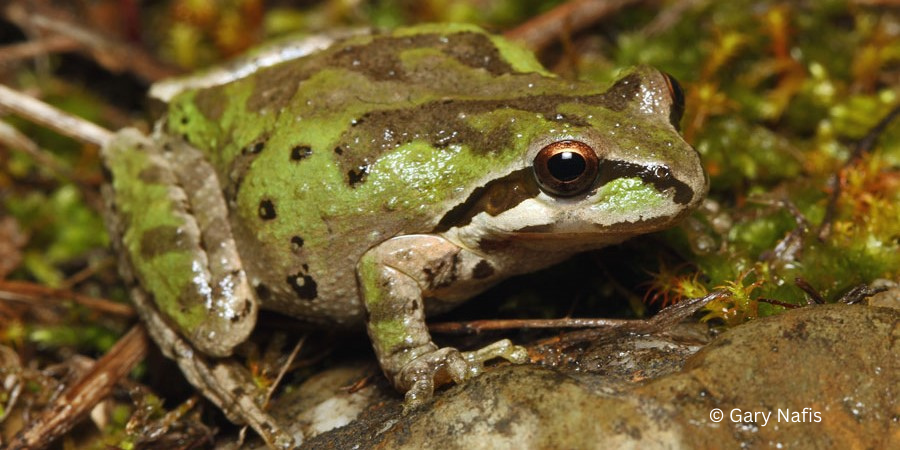
Sierran Chorus Frog (Pseudacris sierra)
Chorus frogs are small frogs measuring about 1-2 inches long. They are usually found on the ground, but occasionally use their large toe pads to climb and cling to shrubs and trees. Most often they are green, but can change color to brown, tan, or cream to blend into their surroundings. Often there is a y-shaped marking between the eyes, extending from the nostrils to the shoulders.
The Sierran chorus frog is found from Humboldt County south to around Santa Barbara County, and from Bakersfield north into the Sierra Nevada and beyond.
Listen to the call of the Sierran chorus frog.

Baja California Chorus Frog (Pseudacris hypochondriaca hypochondriaca)
The Baja California chorus frog looks and sounds very similar to its northern counterpart. It is found throughout southern California, south of Santa Barbara County and Bakersfield, into Baja California. It’s also present on Santa Catalina, Santa Cruz, and Santa Rosa Islands.
Listen to the call of the Baja California chorus frog.
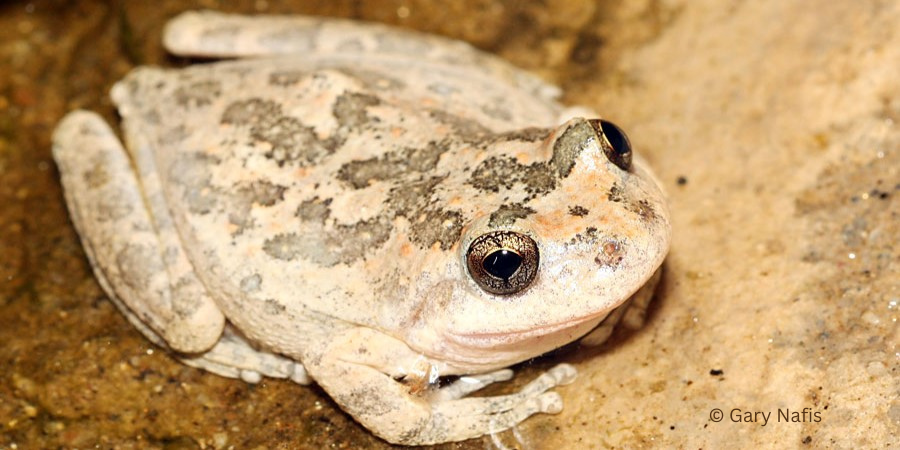
California Treefrog (Pseudacris cadaverina)
California treefrogs are found from San Luis Obispo County south to Baja California. Their range overlaps with the Baja California chorus frog, and they are about the same size, but look closely and you’ll notice differences in appearance. California treefrogs are more muted in color, with gray or light brown to match their habitat. California treefrogs also lack the characteristic “eye stripe” commonly found on chorus frogs. The California treefrog’s skin is rougher and bumpier, and they are more aggressive towards other males during the breeding season.
Listen to the call of the California treefrog.
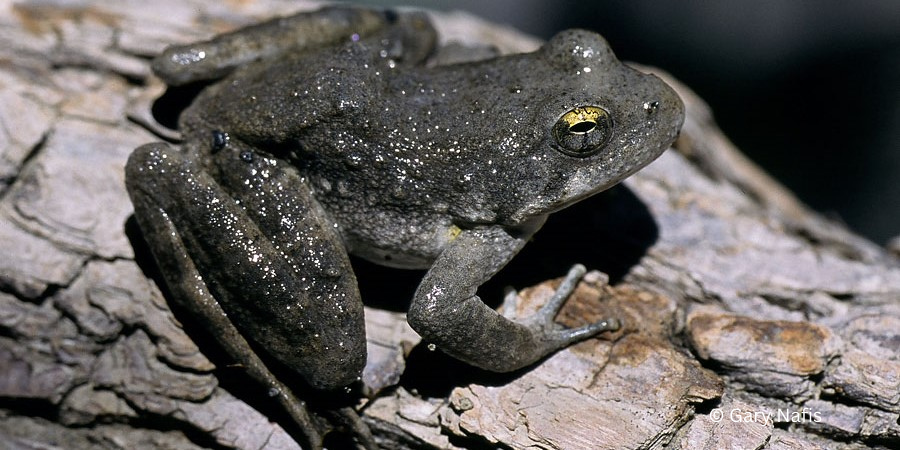
Foothill Yellow-Legged Frog (Rana boylii)
The foothill yellow-legged frog (FYLF) was once widespread throughout the streams and rivers of the Los Padres National Forest, but today has been reduced to scattered populations in Monterey County. All southern FYLF populations have been eliminated, and the frog may disappear from the forest completely unless urgent steps are taken to identify and protect its habitat. In 2023, federal biologists finally placed the species on the endangered species list.
FYLF historically occurred from Oregon south through the San Gabriel Mountains in Los Angeles County. Its habitat consists of streams and rivers within foothill drainages, and as its name implies, its legs and lower abdomen have a notable yellowish color. Adult FYLFs can grow up to three inches long. It’s one of the most poorly-known frog species in California, as no detailed study of its life history has ever been undertaken.
The calls of the FYLF are rarely heard as the frog’s vocal sacs are very small and produce only a faint call. They call mostly underwater, where the sound of the faint call carries more easily.
Listen to the call of the foothill yellow-legged frog and learn more about this endangered species.
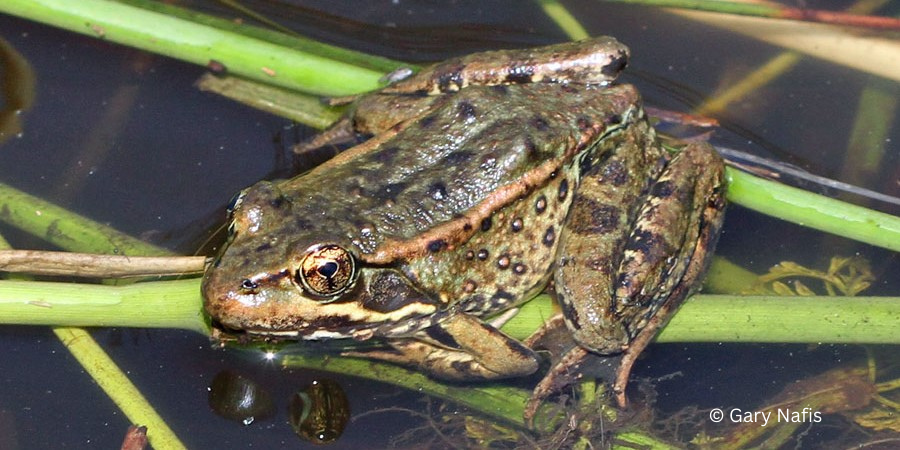
California Red-Legged Frog (Rana draytonii)
The California red-legged frog (CRLF) is the largest native frog in the western United States, growing up to five inches long. It’s the official California State Amphibian, and is known from Mark Twain’s famous short story “The Celebrated Jumping Frog of Calaveras County.” Its distinctive reddish coloring on its belly an beneath its hind legs give the frog its name.
The Los Padres National Forest supports more CRLFs than any other national forest in California. The have been eliminated from over 70 percent of their historic habitat, and today they can be found primarily in the coastal streams and wetlands of Monterey, San Luis Obispo, and Santa Barbara counties. The CRLF was placed on the federal list of threatened and endangered species in 1996.
Once they’ve grown their legs from tadpoles, young CRLFs may disperse from where they were born, sometimes traveling more than two miles in search of new dispersal sites.
Listen to the call of the California red-legged frog and learn more about this threatened species.
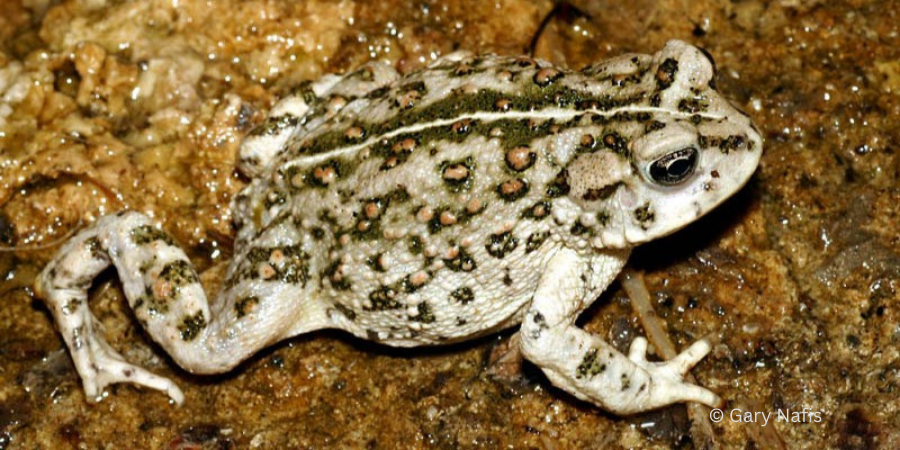
California Toad (Anaxyrus boreas halophilus)
California toads are large and round with dry, warty skin, growing up to five inches long. They look similar to arroyo toads, but have a light-colored stripe down the middle of their backs (arroyo toads don’t have the stripe, so this is an easy way to tell them apart).
They’re found throughout most of northern California and southern coastal California, but are becoming uncommon in many areas due to habitat loss and pollution. Like many toads, they use poison secretions from parotoid glands to deter predators. Some predators have developed an immunity to the poison and will eat toads. Others such as ravens have learned to avoid the poisons by eating only the toad’s internal organs, leaving the skin behind.
Listen to the call of the California toad.

Arroyo Toad (Anaxyrus californicus)
Arroyo toads have perhaps the most specialized habitat requirements of any amphibian found in California—they are found only in rivers with shallow, gravelly pools next to sandy beaches. It has very specific habitat requirements, requiring shallow, slow-moving streams and breeding pools with very specific-sized sand and gravel that allow tadpoles to dig into the sediment to feed.
This small toad was once found throughout coastal rivers and streams from Monterey to San Diego counties as well as in Baja California, but has lost more than 75% of its habitat. The Los Padres National Forest contains some of the best remaining habitat for the arroyo toad, and holds most of the viable populations of arroyo toads that exist today. For this reason, the protection of the remaining arroyo toad populations in the Los Padres is critical to ensure the toad’s continued survival.
Arroyo toads burrow into sand banks during the day, and emerge at night to catch prey and wet their skin. These shallow burrows make them susceptible to crushing by foot and by vehicle. Arroyo toads throughout Southern California, including in Los Padres, continue to be threatened by urbanization; degradation of streamside habitat and siltation of streams from campgrounds, vehicle stream crossings, and livestock grazing; and predation by introduced predatory fish and crayfish.
Listen to the call of the arroyo toad and learn more about this endangered species.
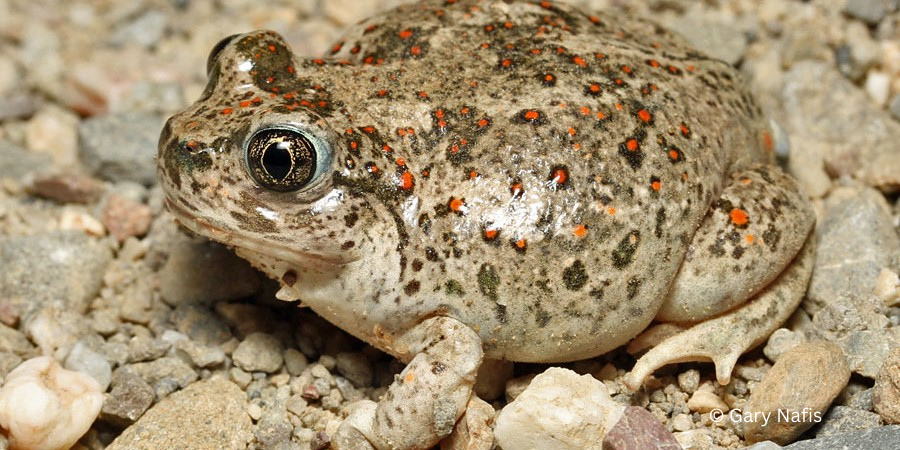
Western Spadefoot (Sepa hammondii)
Spadefoots are so named for the wedge-shaped hardened “spade” on each hind foot. They are able to survive in hot, dry environments by burrowing underground using the spade. They spend most of their life underground, emerging for only a short period each year to breed in water. Another unique feature is their pale gold eyes with vertical pupils. All other frogs and toads in our area have horizontal pupils, but the vertical pupil of the spadefoot helps it see better in the dark.
Spadefoots are found from the Coast Ranges south of Monterey County south to Baja Mexico, as well as within the Central Valley and adjacent foothills. Spadefoots have seen an 80% population decline in southern California and are currently being considered for placement on the federal list of threatened and endangered species.
Their lifespan is 12 years, longer than most other frogs and toads in California. It takes about eight weeks for tadpoles to metamorphose into young toads—the fastest metamorphosis known for any frog or toad species. They breed in vernal pools, seasonal ponds that are only present for a few short weeks after significant rains.
Listen to the call of the western spadefoot and learn more about this imperiled species.






